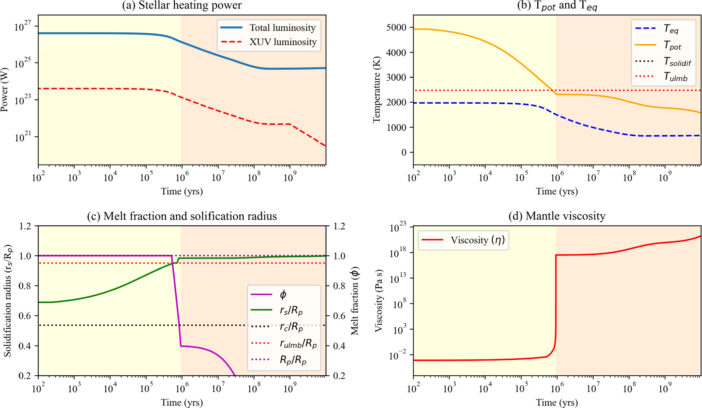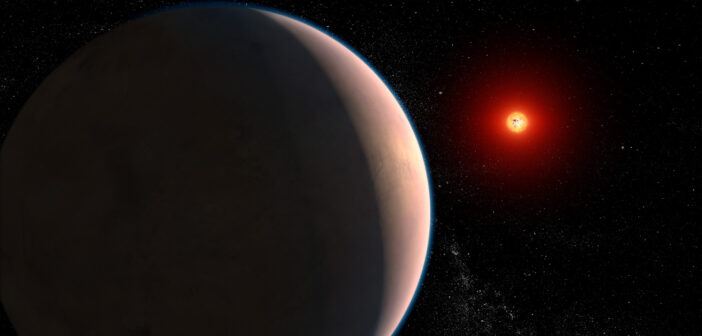Editor’s Note: Astrobites is a graduate-student-run organization that digests astrophysical literature for undergraduate students. As part of the partnership between the AAS and astrobites, we occasionally repost astrobites content here at AAS Nova. We hope you enjoy this post from astrobites; the original can be viewed at astrobites.org.
Title: Unveiling the Interior Structure and Thermal Evolution of Super-Earth GJ 486b
Authors: Chandan K. Sahu et al.
First Author’s Institution: National Institute of Science Education and Research, India
Status: Published in ApJ
Planets between the sizes of Neptune and Earth, known as super-Earths, are the most frequently found planets in the galaxy. With no analog in our solar system, these worlds can offer a unique look at planet formation and evolution, and potentially life in the universe. To truly understand a planet’s environment and assess its potential for habitability, we must look at every part of it. This includes not just the atmosphere, but also the interior. Rocky planets, such as the inner solar system planets, typically don’t have enough gravitational pull to retain their primary atmospheres. Thus, only their secondary atmospheres remain. These secondary atmospheres are directly linked to the interior of the planet and are usually formed by volcanic outgassing, material from impacts on the planet’s surface, and other interior processes. By observing a rocky planet’s atmosphere and determining its composition, we can learn something about the interior of the planet as well.
The subject of today’s article, GJ 486b, is a warm super-Earth orbiting an M-dwarf star every 1.5 days. The transmission spectrum of the planet was recently observed by JWST, and when the data were analyzed, a potential water-rich atmosphere was discovered! Today’s authors take these recent discoveries of GJ 486b’s atmosphere and use them to model the interior of the planet.
One Model to Rule Them All
The interiors of rocky planets are not very well known. This is because the best way to understand what’s inside a rocky planet is through seismology. In order to do this, one must put a seismograph on a planet’s surface and measure how seismic waves move through the material inside the planet. Only three bodies have had seismographs landed on them: Earth, the Moon, and Mars. Rocky exoplanet interiors are even harder to understand when the only properties we know are the planet’s mass, radius, and certain aspects of its atmosphere. To understand exoplanet interiors, we have to use modeling to infer properties of the inside of the planet.
The authors of today’s article use the 1-D modeling package SERPINT (“structure and evolution model for rocky planet interiors”) to model GJ 486b’s interior based upon JWST observations of its atmosphere and assumptions made about rocky planets. Their model is broken down into four different parts, as illustrated in Figure 1.

Figure 1: Flowchart of SERPINT and the four different modules used in the overall model of GJ 486b’s interior. Arrows between each property indicate that they’re dependent on one another. [Sahu et al. 2025]
Taking all of these factors into account is important when creating a comprehensive picture of a planet. Each module models different processes that influence the planet’s interior, surface, and atmosphere, making sure that we’re taking all of these things into account when trying to understand the planet. It truly is one model to rule them all.
Outgassing and Photolysis and Escape, Oh My!
The authors start the model for the planet and star together and allow them both to evolve for 10 billion years. The planet starts with a mantle temperature of 5000K, which ensures the surface is molten, creating a magma ocean. This is typically how we think all rocky planets, including Earth, started their formation. Figure 2 illustrates how the mantle solidifies over time, influencing the overall structure of GJ 486b. Both layers of the mantle start to cool after the start of the simulation, and the lower mantle cools and solidifies first, followed by the upper mantle. This is due to the different composition in each layer and thus, a different temperature at which they will solidify. Cooling is delayed for a while due to internal heating from radioactive decay of the elements. This can be seen in Figure 2b with the shallow slope of the orange line. The orange line represents the mantle’s equilibrium temperature, and the yellow shaded region is the time in which the mantle has not yet solidified. As the mantle cools, it turns into a thick mush and then eventually into solid rock (as shown in Figure 2d). This indicates the mantle has solidified, and we move from the yellow shaded region on the graphs into the orange shaded region.

Figure 2: Evolution of different parameters associated with the modeling of the mantle (outer layer) of GJ 846b. Plot (a) shows how the host star changes its total luminosity (blue) and X-ray and ultraviolet luminosity (red) over time. Plot (b) shows how the mantle equilibrium temperature (orange) evolves towards the planet’s equilibrium temperature (blue). The red dashed line indicates the temperature at which the mantle completely solidifies. Plot (c) shows how the boundary between the mantle and other layers shifts over time as the mantle solidifies. This is shown in green. The magenta line in this plot shows the evolution of the radius at which the mantle is solidified. Plot (d) shows how the mantle viscosity changes over time as the mantle solidifies. The yellow shaded region indicates a time in which the mantle is not solid while the orange shaded region indicates a time after the mantle has solidified. [Sahu et al. 2025]

Figure 3: Evolution of the sources of water on GJ 486b. The blue line shows the mass of water in the solid part of the mantle. The orange line shows the mass of water in the melting part of the mantle. The green line shows the mass of atmospheric water, and the red line shows the escaping atmospheric water. Each of these sources of water is crucial to understanding the life cycle of water on this planet. [Adapted from Sahu et al. 2025]
Original astrobite edited by Tori Bonidie.
About the author, Kaz Gary:
I am a third-year PhD student at The Ohio State University with a focus in exoplanetary science. My current work focuses on modeling exoplanet observations for two upcoming space-based telescope missions: the Twinkle satellite and Habitable Worlds Observatory. Outside of research, I help develop exoplanet-focused shows for the Arne Sletteback Planetarium at OSU. In my free time, I enjoy playing tabletop RPGs, painting, watching terrible reality TV, and hanging out with my pet hedgehog.
